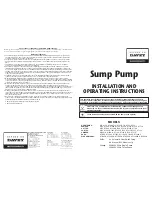
3-1-618 Page 4
relief valve must be set to relieve at a pressure
equal to or below the rated capability of the lowest
rated component.
Before starting the pump every time, check to
insure:
• The pressure relief valve is in good
operating condition and has been set to the
proper relief pressure.
•
Any pipe line used to direct pressurized relief
flow to another location, such as a collecting
tank, is not blocked.
•
The discharge system is not blocked and all
the discharge line valves are open.
Check all fluid end discharge system
components including pipe, connections,
elbows, threads, fasteners, hoses, etc., at least
once every six months to confirm their
structural adequacy.
With time, wear, corrosion
and fatigue can reduce the strength of all
components. Magnetic iron and steel components
should be checked with magnetic particle or dye
penetrate crack detection equipment. Nonmagnetic
materials should be checked for cracks with dye
penetrants. All metallic components should also be
visually checked during these inspections for signs
of corrosion. If a component shows evidence of
cracking or loss of material due to corrosion it must
be replaced with a new part.
Continually monitor suction and discharge hose
assemblies when the pump is operating for leakage,
kinking, abrasion, corrosion or any other signs of
wear or damage.
Worn or damaged hose assemblies should be
replaced immediately.
At least every six months
examine hose assemblies internally for cut or
bulged tube, obstructions and cleanliness. For
segment style fittings, be sure that the hose butts up
against the nipple shoulder, the band and retaining
ring are properly set and tight and the segments are
properly spaced. Check for proper gap between nut
and socket or hex and socket. Nuts should swivel
freely. Check the layline of the hose to be sure that
the assembly is not twisted. Cap the ends of the
hose with plastic covers to keep them clean until
they are tested or reinstalled on the pump unit.
Following this visual examination, the hose
assembly should be hydrostatically tested, on test
stands having adequate guards to protect the
operator, per the hose manufacturer’s proof test
procedure.
Fluid end component inspections should be
performed more frequently than every six
months if pressures above 2,500 PSI are used in
the discharge system or if corrosive, flammable
or hot (over 110º F) fluids are being pumped.
Before starting the pump the first time and
periodically thereafter check the pump, suction and
discharge system fastener torques versus the
values listed on page 26 to insure proper tightness.
Over and under torquing can damage threaded
pipes, connections and fasteners, which may lead
to component damage and/or failure. Replace all
components found to be damaged or defective.
Block the crankshaft from turning and make certain
that all pump drive motor or engine start switches or
starter controls are clearly tagged with warnings not
to start the pump while repair work is in process.
Whenever the pump is operating, continually
monitor the entire suction, discharge and pump
lubricating systems for leaks. Thoroughly
investigate the cause for leakage and do not
operate the pump until the cause of the leak has
been corrected. Replace any parts which are found
to be damaged or defective. When a gasketed joint
is disassembled for any reason, discard the used
gasket and replace it with a new, genuine Gardner
Denver gasket before reassembling the joint.
Due to the high working pressures contained by the
fluid cylinder, discharge manifold and discharge
piping, welding on these components is not
recommended. If welding on the discharge system
cannot be avoided, only experienced, qualified
welders should be used. In addition, the welded
part should be hydrostatically proof tested in the
shop with water or hydraulic fluid to one and one
half times maximum discharge system working
pressure, with no observable fluid leakage, before
the part is reinstalled in the pump system.
In summary, high pressure fluid streams can
possess sufficient energy to cause personal injury,
death and/or equipment damage. These results
can occur either through direct contact with the fluid
stream or by contact with loose objects the fluid
stream has propelled, if the pump system is
improperly used, or if the fluid is misdirected, or
allowed to escape from defective or improperly
maintained equipment.
DANGER
Do not attempt to service, repair, adjust or
otherwise work on the pump while the
unit is operating. Shut off the pump drive
motor or engine and relieve the fluid
pressure in the pump suction and
discharge systems before any work or
investigation is performed on the pump or
pump systems.











































